Here is the first part (its not a complete draft) of my "What's the right way for people to eat?":
It’s definitely hard to say what the one right way to eat is, but in order to consider what the right way to eat is it’s important to understand what you want to get out of eating first. I believe that the right way to eat will leave a person healthy and happy and the only way to truly achieve that is to eat food from your community. This means more though than just buying locally, this means planting, growing, killing and cooking your food in and with your community. Eating food from your own community means cutting out the processed food that many of the money oriented food producing companies are making, and in turn cutting out some of the most unhealthy things people eat today. It also means more fresh food, which is a way to introduce more healthy food into your diet. If you are producing and cooking your own food, the food is coming from your community, which means short travels to get it, and less money because you and your community are working for it and cutting out the cost of shipment and most importantly the money tapped onto the cost of food by the companies you are buying it from. And lastly, community based food programs are more ethical. Without the need for mass production animals raised for meat will not have to live in the gruesome conditions, and many don’t necessarily need to be raised by the community, hunting becomes one of the methods for gathering food. Along with the better treatment for the animals comes better treatment for people, community based programs allow for a shorter chain of people working to produce and distribute the food, and all the participants are doing it for the own good, cutting out many of the worker issues. Through community based food programs not only is their healthier food, more accessibility and better ethics but there is an improved quality of life in the community.
Health
World Health Organization defines health as, “a state of complete physical, mental and social well-being and not merely the absence of disease or infirmity.” Which means that being healthy is not only about eating right, keeping proper nutrients in your body and exercising to keep your body physically fit, but also about keeping your mind and your human relations in good state. Working in a community based food system supports eating right, exercising and staying active and working and relating to your community, all of which do the job to keep you healthy.
Nutrition and Preservatives
Eating raw food may not be better than eating cooked food but it is more nutritional. This is because by heating the food the chemical make up of it changes and many of the vitamins and amino acids that the food has when it is fresh are broken down (living-foods.com). But whether or not your eat raw food doesn’t always depend on whether or not your food is being produced locally, you could be eating only local food but still cooking it all. What is does affect though is the fact that processed food is processed in all different kinds of way and heating is one of them. Like heating food to preserve it, there are other ways food is preserved and even some of those ways also use heating. Frozen food is persevered by taking the fresh food, dropping it into boiling water (to kill off microbes) and then freezing it. Canned food is preserved by first taking the food and heating it and then placed in a can and sealed (often in metal cans, which can contaminate the food). Pasteurizing, smoking and sterilizing are three other ways food is processed with heat. Other ways food is processed is through methods of salting, pickling, drying and irradiating (exposing the food to radiation) the food (informedeating.org).
To completely stop food processing would be impossible and unhealthy, people have been processing food as a way to preserve since the prehistoric ages and advanced greatly in the 19th and 20th century to serve military needs (wikipedia.org). Processing food is the only way to preserve it so it will not rot during off seasons of certain foods. And community base food programs would have to preserve their food because they wouldn’t be buying produce from other places that have the food they do not.
What community-based food programs do eliminate is the use of chemicals in process and preserved the food. Although it is not true that all chemicals are unhealthy and harmful to the human body and environment, many of them are. And one introducing chemicals into the body is unhealthy. Taking steroids is know to be bad for the body, but much of the beef in your supermarket was once a cow that was injected with steroids to make it grow bigger and faster. Humans have evolved over the last 200,000 years eating plants and fungi they collected and animals they hunted in the nearby area (wikipedia.org) until recently when food became another major and global industry. As humans evolved eating such things, they did not evolve to consume such chemicals that are being added in great quantities to the food you can find in the supermarket today. Excess salt causes hypertension (high blood pressure and arterial disease), saturated fats cause heart disease and obesity, excess sugar causes dental caries and diabetes and all the chemical additives cause cancer (informedeating.org). If you are producing and eating locally, you are processing your own food and therefore controlling the substances that preserve the food and can potentially destroy life.
Physical Health
The physical health aspect of community based food systems is simple, by working to produce the food yourself you are maintaining an active physical routine that will keep you in shape. Human evolved eating that food they had hunted and gathered and in doing so were able to get an equivalent amount of exercise many people do by going to the gym to stare at a wall and run on a moving piece of floor. If people are working to produce their own food they have to be working to grow and gather their own plants, raise their own animals and/or hunt there own animals, which all requires more energy and burns more calories than walking to a local supermarket or ordering from Fresh Direct. In America adults are encouraged to exercise for 30 minutes a day (fitness.gov), if just that is sufficient for keeping people in shape people working to produce their own food easily meet that standard.
Mental Health
Like physical health, mental health is also something that becomes very simple in a community-based food system. By working with the land and with the community, people achieve personal happiness and positive social interaction. In a story about a man who works with chronically ill people in an organic garden he says, “I personally believe that a huge benefit comes from a renewed relationship with nature. It starts with an ‘I won't poison you, you won't poison me’ attitude, and ends with ‘I'll nurture and respect you, you nurture and respect me’” (lookwayup.com/free/organic.htm), which goes to show that through growing food people become in touch with themselves and the earth, finding some personal satisfaction. The social aspect is also apparent in that people in the community are working together to feed themselves and each other; by working within a community people are able to experience companionship with and support from other members of the community. And with such personal and communal benefits, people working in community-based food systems are able to achieve a better state of mental health.
Sunday, February 25, 2007
Wednesday, February 14, 2007
Nutritional and Historical Lenses at the Supermarket

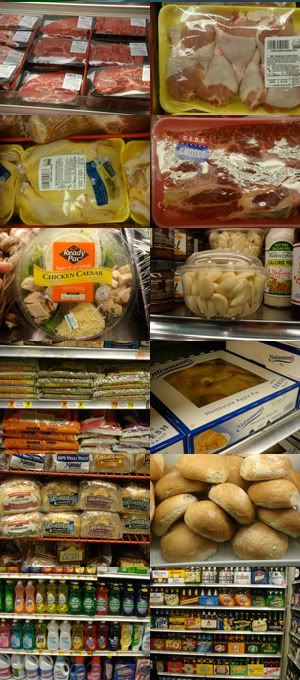
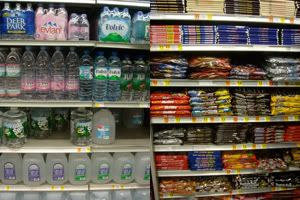
Nutritional
How do organic products differ?
If given the chance, I usually chose organic products over non-organic products. I like to think organic products are better for me. What I have never done is actually done is compared the nutritional values. I did this with organic eggs and non-organic eggs in the supermarket today.
Organic Eggs Vs. Non-Organic eggs
- 0.5g less fat in Organic eggs
- 0.5g less saturated fat in Organic eggs
- 55mgs less cholesterol in Organic eggs
- 15mg less sodium in Organic eggs
- 2g less protein in Organic eggs
- Same amount of Carbohydrates
- 2% les vitamin A and Calcium in Organic eggs
And then I compared them to packaged egg whites, which have nothing in then except for 95mgs of sodium, 90mg of potassium (not mentions on the other egg’s nutritional values), 1g of carbohydrate (the same as the eggs) and 6g of protein.
Plastic wrap (the meat) can’t be good for you.
How does the nutritional value of fresh food compare to the nutritional values of packaged and processed food?
How does packaging food change its nutrition?
What preservatives go into all the packaged foods? What are the ingredients labeled (with words no one knows) are the preservatives?
History
When did meats begin to be packaged the way they are, with plastic wrap?
People on a farm, eating their own chickens, never have the choice to have 6 legs, rather than a whole chicken.
What happens to the left over meat? How much is wasted? How does meat waste compare to 100 years ago?
How long have foods been packaged with so much wrapping?
When were supermarkets invented? How have they changed?
Is there a difference in the nutritional values of modern food and food from 100 years ago?
When were pre-packaged meals first introduced onto the food market and where? How has it changed the way people eat?
When was bottled water introduced to the food market?
Tuesday, February 13, 2007
Mixing Things up at Burritoville

I considered myself someone who didn't eat fast food because I don’t eat at McDonalds or Burger King, but as it turns out, I am really eating fast food at least once a week. And that’s because I am a Burritoville junkie. So I took this project as an excuse to eat there today.
When I got there with Devin, neither of us knew what we wanted so we ate some tortilla chips with salsa while we decided. I tried to order some salad my mother ordered from there this weekend, but I didn’t order it right and I didn’t get exactly what I was hoping for. I ordered a salad in the fried tortilla shell, which I didn’t get, but I asked for it after I noticed there wasn’t one. So I started eating my salad that consisted of lettuce, tomato, some sort of jerk chicken, tortilla chips, guacamole, cheese and sour cream. I started eating it and thought it tasted pretty good. Then my shell was ready so I took half of my salad and dumped it into the shell. I broke the shell off into a chip size and shoveled some salad onto it with my fork and took a bite.
I gave some of my shell to Devin, who thought it was so good he order one for himself, to eat with his burrito-bowl, which I also ate. The burrito bowl had lettuce, brown rice, black beans, a green hot sauce, chicken, cheese and sour cream. When I was eating that I tasted mostly the chicken, beans and rice, what I didn’t taste, and Devin said was pretty hot, was the green hot sauce. Devin dumped his whole burrito bowl into his friend tortilla shell.
We kept eating and towards the bottom of my salad I realized the bottom of the shell we soggy and gross, go figure. I was thinking about how unhealthy these fried tortilla shells were, how if you go to the fair everything is fried like this. (That’s when Devin says, “we should eat these with everything.”)
Anyways, we kept eating the food and then I decided to mix what was left in my bowl with what was left in Devin’s, so I just emptied my plate of food onto his. At that point, I was full but I kept eating what tasted like a pure concoction. Eventually I stopped eating the burrito-bowl-salad concoction and ate a few more tortilla chips, dipping them in sour cream, before I finally stopped eating all together. I felt bloated and gross afterwards from eating so much, but that usually how I feel after I leave Burritoville. Outside I ate a few peanut M&Ms; the chocolate was perfect tasting.
Sunday, February 11, 2007
Composting
When can we start? How do we do it?
We can start composting today. Compost is a way of recycling left over food, dried leaves and other organic materials. It then can be used instead of commercial fertilizers to give nutrients to the soil and plants. Compost consists of a ratio of materials rich in carbon and nitrogen. Carbon-rich, also called “browns,” are things like dried leaves, straw and wood chips. Nitrogen-rich, also called “greens” are things that are fresh or green like grass and kitchen scraps (left over lettuce, egg shells, anything but meat mostly). For every 1 part “green” you want about 25 parts “browns.”
What Variety?
There are million varieties of compost; it all depends on what type of material you put into the compost. But generally compost is just one mixture of many different things. Variety doesn’t apply to compost the same way it does apple trees or chickens.
Issues/Concerns
The only issues or concerns I have about the compost is that it would smell. This would be caused by too much of the nitrogen-rich material not mixed with enough carbon-rich material.
Links
General
http://www.compostguide.com/
http://web.extension.uiuc.edu/homecompost/building.html
http://www.care2.com/channels/solutions/outdoors/211
The Purpose of Compost
http://www.kitchengardeners.org/2006/04/compost_it_will.html
Building a Compost Bin
http://www.taunton.com/finegardening/pages/g00148.asp
http://www.environmentaldefense.org/article.cfm?ContentID=2030
Complete Instructions
http://www.gardenorganic.org.uk/organicgardening/compost_pf.php
We can start composting today. Compost is a way of recycling left over food, dried leaves and other organic materials. It then can be used instead of commercial fertilizers to give nutrients to the soil and plants. Compost consists of a ratio of materials rich in carbon and nitrogen. Carbon-rich, also called “browns,” are things like dried leaves, straw and wood chips. Nitrogen-rich, also called “greens” are things that are fresh or green like grass and kitchen scraps (left over lettuce, egg shells, anything but meat mostly). For every 1 part “green” you want about 25 parts “browns.”
What Variety?
There are million varieties of compost; it all depends on what type of material you put into the compost. But generally compost is just one mixture of many different things. Variety doesn’t apply to compost the same way it does apple trees or chickens.
Issues/Concerns
The only issues or concerns I have about the compost is that it would smell. This would be caused by too much of the nitrogen-rich material not mixed with enough carbon-rich material.
Links
General
http://www.compostguide.com/
http://web.extension.uiuc.edu/homecompost/building.html
http://www.care2.com/channels/solutions/outdoors/211
The Purpose of Compost
http://www.kitchengardeners.org/2006/04/compost_it_will.html
Building a Compost Bin
http://www.taunton.com/finegardening/pages/g00148.asp
http://www.environmentaldefense.org/article.cfm?ContentID=2030
Complete Instructions
http://www.gardenorganic.org.uk/organicgardening/compost_pf.php
Friday, February 9, 2007
Healthy Eating - Class Questions
What food seems healthy?
I think healthy eating would be eating lots of fruits, vegetables, whole grains, soy and some animal products. Here are some things that come to mind:
Fruits – mango, pineapple, apples, papaya, berries (various kinds), bananas, tomatoes, peppers.
Vegetables - lettuce, spinach, corn, beets, carrots, onions, garlic, carrots, leeks, celery.
Grains & Wheat - barley, brown rice, wild rice, whole grain bread, whole-wheat bread, whole grain cereals.
Meats, fish and others – Chicken, turkey, tofu, salmon, cod, tuna (fish only sometimes because of mercury levels.
Here is a 3-day menu that is a little boring but I consider healthy eating:
Day One
Breakfast – Fruit salad, eggs with turkey sausage, whole grain toast with smart butter (non-dairy, not margarine), and fresh squeezed orange juice.
Lunch – A turkey sandwich with lettuce or fresh spinach, tomato, mustard, mayo and cheese.
Dinner – Salmon burgers with whole grain bread, lettuce and tomatoes, a salad with fresh vegetables and a side of roasted vegetables (potatoes, squash, parsnips).
Day Two
Breakfast – Whole grain hot cereal (like oatmeal) with maple syrup or honey, low fat or soymilk, topped with fruit and fresh squeezed orange juice or hot tea.
Lunch - Chicken soup with barley, onions, carrots, zucchini, corn, spinach, celery and spices, some whole grain bread/toast and a small side salad with fresh vegetables.
Dinner – Lasagna with tomato sauce and full of vegetables (carrots, onion, basil), toast and a salad.
Day Three
Breakfast – Strawberry or banana pancakes with whole-wheat flour and maple syrup, fruit salad and fresh squeezed orange juice.
Lunch - Tuna salad (with celery, pepper, radish) sandwich with lettuce and tomatoes on whole grain bread. Noodle soup with lots of vegetables (corn, zucchini, onions, carrots, etc.).
Dinner – Chicken baked with herbs and brown rice and artichokes with a vinaigrette sauce
In general, if I could eat anything it would be soups. I think soups are tasty and a good way to combine many healthy ingredients, I almost think I would eat soup (different soups of course) for every meal.
What should people eat?
I think people should eat lots of fresh food. I think that eating meals is important; I think healthy snacks are fine but should not have too much sugar or artificial ingredients. I think people should be able to eat what they want, but I think that if I were to control the food market I would take out a lot of the snack food and candies that are full of sugar and lack nutrients. I also think that it is important for people to eat "real" food, rather than stuff that has been processed so much. For example I think people should eat Macaroni and Cheese made with real cheese, rather than the powered stuff that comes in a box. But most importantly I believe food is something people should enjoy and if some people want to eat unhealthy, sugary things and it will make them happy, they should go for it. What is important to remember though, is to balance what you are eating and not eat too much.
I think healthy eating would be eating lots of fruits, vegetables, whole grains, soy and some animal products. Here are some things that come to mind:
Fruits – mango, pineapple, apples, papaya, berries (various kinds), bananas, tomatoes, peppers.
Vegetables - lettuce, spinach, corn, beets, carrots, onions, garlic, carrots, leeks, celery.
Grains & Wheat - barley, brown rice, wild rice, whole grain bread, whole-wheat bread, whole grain cereals.
Meats, fish and others – Chicken, turkey, tofu, salmon, cod, tuna (fish only sometimes because of mercury levels.
Here is a 3-day menu that is a little boring but I consider healthy eating:
Day One
Breakfast – Fruit salad, eggs with turkey sausage, whole grain toast with smart butter (non-dairy, not margarine), and fresh squeezed orange juice.
Lunch – A turkey sandwich with lettuce or fresh spinach, tomato, mustard, mayo and cheese.
Dinner – Salmon burgers with whole grain bread, lettuce and tomatoes, a salad with fresh vegetables and a side of roasted vegetables (potatoes, squash, parsnips).
Day Two
Breakfast – Whole grain hot cereal (like oatmeal) with maple syrup or honey, low fat or soymilk, topped with fruit and fresh squeezed orange juice or hot tea.
Lunch - Chicken soup with barley, onions, carrots, zucchini, corn, spinach, celery and spices, some whole grain bread/toast and a small side salad with fresh vegetables.
Dinner – Lasagna with tomato sauce and full of vegetables (carrots, onion, basil), toast and a salad.
Day Three
Breakfast – Strawberry or banana pancakes with whole-wheat flour and maple syrup, fruit salad and fresh squeezed orange juice.
Lunch - Tuna salad (with celery, pepper, radish) sandwich with lettuce and tomatoes on whole grain bread. Noodle soup with lots of vegetables (corn, zucchini, onions, carrots, etc.).
Dinner – Chicken baked with herbs and brown rice and artichokes with a vinaigrette sauce
In general, if I could eat anything it would be soups. I think soups are tasty and a good way to combine many healthy ingredients, I almost think I would eat soup (different soups of course) for every meal.
What should people eat?
I think people should eat lots of fresh food. I think that eating meals is important; I think healthy snacks are fine but should not have too much sugar or artificial ingredients. I think people should be able to eat what they want, but I think that if I were to control the food market I would take out a lot of the snack food and candies that are full of sugar and lack nutrients. I also think that it is important for people to eat "real" food, rather than stuff that has been processed so much. For example I think people should eat Macaroni and Cheese made with real cheese, rather than the powered stuff that comes in a box. But most importantly I believe food is something people should enjoy and if some people want to eat unhealthy, sugary things and it will make them happy, they should go for it. What is important to remember though, is to balance what you are eating and not eat too much.
Thursday, February 8, 2007
Introduction to Locally Available Apples

Left: Cameo Apple Right: Mutsu Apple
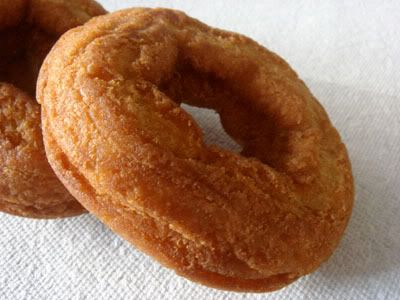
Apple Cider Donut
a.) What is this food?
These are two different kinds of apples. One is a Cameo, which is similar to a Fugi apple. It is red, yellow and green. It is a medium size and supposedly sweet. Like most apples, it is a round shape, but compared to some of the other apples it is not as perfectly round. When looking through the crates of Cameo apples they seem to be very asymmetrical. The other apple is called a Mutsu and is a crossbreed of a granny smith apple and a sweet delicious apple. The apples are a greenish yellow and orange color. The greener they are (the ones that look more like granny smiths) are sourer/tarter and the more orangey colored ones are sweeter and taste more like the golden delicious.
Whatever apples don't get sold at the farmer market are taken back to the farm and made into apple cider and apple cider donuts.
b.) Why is it good to eat apples?
Apples are good to eat because they are full of pectin, which is a soluble fiber that can reduce cholesterol and protect against environmental toxins. They are also a good source of vitamin C. The fiber in apples is also good for your digestive system and will help you poop. Apples are esthetically good because they are crunchy, sweet and fun to eat. And as most everyone knows from looking at the food pyramid that you are supposed 2-4 servings of fruits a day. Plus, an apple a day keeps the doctor away.
c.) Who sells it? Where?
These apples are grown by a farmer named Ken Migliorelli on the Migliorelli farm in Tivoli, NY. The Migliorelli farm is 550 acres and grows large quantities of apples, other fruits and vegetables. At the farmers Market at union square, in the middle of winter, the Migliorelli Farm stand sells apples, pears, apple cider donuts and apple cider. In the summer they sell other fruits like peaches and vegetables like lettuce, tomatoes and cucumbers. They also have another Migliorelli farm stand in Hudson valley, closer to the farm. The man who sold me the apples had been working for the Migliorelli farm for 13 years. That he woke up at 1 in the morning to go to the farm, get the apples and drive them to NYC 3 days a week.
Migliorelli Farm
46 Freeborn Lane
Tivoli, NY 12583
USA
tel: 845-757-3276 or 914-757-FARM
d.) How do they grow it?
When I asked the man at the farmers market how these apples are grown he said, “They plant the seed, water it and wait. Then it grows and there are flowers on the tree.” So I’m guessing there isn’t anything very special about how these apples are grown. I asked about pesticides and the man told me that Migliorelli Farm uses “very expensive pesticides that wash off by just rinsing the apple with water.” He also noted that he eats them without rinsing them and he’s “fine.”
e.) Links
General information about Apples
http://www.bestapples.com/healthy/index.html
http://www.vegparadise.com/highestperch39.html
http://health.learninginfo.org/apple.htm
Specific information about the Cameo Apple
http://www.cffresh.com/fresh/cameo_profile.html
Specific information about the Mutsu Apple
http://www.cffresh.com/fresh/mutsu_profile.html
Cooking Pasta
I began by boiling about 6 or 7 cups of water. I put it in the medium sized pot, on the bottom left flame, because that is the hottest flame on my stove. Then I waited for the water to boil. I walked away and came back when I could hear the little metal piece on the lid bouncing up and down, which is an indication that the water is boiling. Then I poured in a little more than half a box of colorful, cylindrical spiral pasta. I let it cook for about 10 minutes, until it was soft. I tested it before I turned off the flame. The first time I tested it was softer on the outside but still a little hard on the inside. I let it cook more and when I tested it again, it was the right softness. I took the pot off the stove and over to the sink where I poured the pasta into the colander. Then I was done. The End.
Tuesday, February 6, 2007
In My Stomach and On My Plate
For dinner I went out to the diner and had a Caesar salad with chicken. But I didn’t bring my camera. The chicken was crispy, like it had been cooked in a pan, was thin and dry. It was cooked with rosemary, which was not obvious at first, but I tasted it afterwards when I was eating the chicken without the lettuce and dressing. The dressing was creamy and salty from the anchovies, which I thought about as I ate because I really don’t like anchovies but I didn’t mind the dressing. But thinking about the salt and anchovies, I wasn’t as tempted to pick of the pieces of lettuce drenched in it on the bottom. The croutons were big, crunchy and fake buttery. They were fun to eat but I didn’t think they were the best, I can’t identify the specific taste that reminded me of something artificial. Overall, my salad was pretty good and I felt better eating it than I usually do when I go to the diner and order a burger. But I didn’t go to the diner without having some of a burger. My (fat ass) boyfriend had a buffalo burger with bacon and cheese, French fries with gravy and coleslaw. The gravy tasted like chicken gravy and I would say was not too thick and not too thin. The French fries were limp, soft and salty, and combined with the gravy tasted even saltier and felt mushier. The burger, I cant even remember what I tasted most but am sure I tasted everything on it, had gravy pepper jack cheese, bacon, lettuce and tomato. Thinking back now, I remember the strongest flavor and sensation was the bacon. It was harder to chew (all the fat) and tasted salty and meaty and delicious. The buffalo burger tastes fresher and is less chewy than a beef burger. I couldn’t really taste the gravy, I just knew I ate it after it squirted out from the burger and onto my face; just what I love. The tomato was ripe and juicy, which added moisture to the bite. The lettuce was crunchy. I couldn’t really taste the cheese, which I expected to be spicy and flavorful but it wasn’t. The coleslaw was moist, sweet and mayonnaise-packed. The cabbage was crunchy, but not too, because it had been marinating in the mayo. When I got to the middle I noticed there were raisins in it, which probably added to the sweetness. I didn’t eat them because I don’t like raisins. For desert we ordered strawberry shortcake. The cake was fluffy and soft. The white icing was light and didn’t taste as much like coolwhip as I expected, not did it taste like heavy cake icing. It was sweet, but not too sweet. The strawberries had been marinated in some sugary substance like, and were soft and super sweet. The sugary substance, which the strawberries floated in, was jam like and transparent red. On top was a fresh strawberry with a nasty layer of some clear sugar coating. I tasted it and it just tasted like some gross sugar mixture. The strawberry was crisp but mixed with the taste of the sugar layer wasn’t that good.
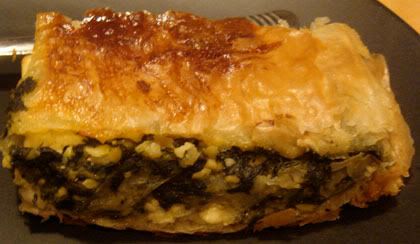
When I came home my mom was making dinner for herself and my father. I ate some spinach pie. The outside was flaky, but not greasy like some other spinach pie I have had. The inside was sweet, the cheese and everything was moist. The spinach didn’t taste dry and make my teeth feel funny, which happens sometimes when I east steamed spinach. The whole thing was soft on the inside and barely crispy on the outer layer. The bottom layer of dough was soft and moist. The spinach pie was definitely worth eating even though it was sort of a second meal and I should probably not eat so much.

When I came home my mom was making dinner for herself and my father. I ate some spinach pie. The outside was flaky, but not greasy like some other spinach pie I have had. The inside was sweet, the cheese and everything was moist. The spinach didn’t taste dry and make my teeth feel funny, which happens sometimes when I east steamed spinach. The whole thing was soft on the inside and barely crispy on the outer layer. The bottom layer of dough was soft and moist. The spinach pie was definitely worth eating even though it was sort of a second meal and I should probably not eat so much.
On My Plate

On my plate: Pad Thai, Pad Woon Sen, Green Curry, Masaman Curry and Thai Fried Rice.
Eating The Pad Thai
The Pad Thai is a Thai noodle made with brown tofu, eggs, beans sprouts, scallions and peanuts. The noodles are soft and bigger, the strongest flavor is the peanut. When I fill my mouth with a bite of Pad Thai noodles, it fills my mouth completely and chewing is soft and full. The bits of peanuts create something chunky amongst the softness of the noodles. The pieces of tofu that look like eggs in fried rice, adds another softer texture, but because of the soft noodles and the lack of flavor that the tofu has, I don’t know exactly what it tastes like. But the tofu adds an interesting texture. The bean sprouts add crunch and moisture. When I keep chewing, the Pad Thai turns into a big ball of soft mush in my mouth, and when I swallow it goes down nice and easy.
Eating The Pad Woon Sen
These small noodles fill my mouth completely differently than the Pad Thai, they tickle and touch all the sides of my mouth, and are easy to bite apart. They don’t have much flavor, except for when you bite down and can taste the green onion.
Eating The Green Curry
This is the spiciest item on my plate. The green curry is a mixture of vegetables, including bamboo shoots, basils, bell peppers, zucchini and cabbage, cooked in coconut milk and green chili paste. My favorite ingredient is the cabbage, which is sweet amongst the spicy sauce. There is an interesting mixture of textures with the small pellets of softer rice and the crunchiness of the cabbage and the bamboo shoots and the softness of the cooked peppers. When eating this green curry, the chili paste is very spicy and burns the inside of my mouth. The coconut milk sauce that the vegetables are made in mixes with the rice and makes a sort of soupy mixture that is soft and doesn’t require very much chewing. It is easy to chew but is very spicy.
Eating The Masaman Curry
This Curry is made with chili paste, potatoes, peanuts and onions. Compared to the Green curry, this curry is not as spicy, and tastes very strongly of peanuts. I didn’t get any potatoes and ended up eating the sauce with the peanuts and onions over rice, like the soupy mixture the green curry made. The peanuts were crunchy but the rice was soft and the sauce hot (in both ways) and smooth.
Eating The Thai Fried Rice.
This friend rice tastes a lot like friend rice from the Chinese restaurant. It is made with rice, scallions, onions, carrots tomatoes and eggs. The rice is greasy, it is soft and brown but it doesn’t tastes like it’s been pan friend. The carrots are sliced in circle/oval shapes, with a zigzag pattern around the edge, crunchy in the middle and softer around the outside. They taste moist, and sort of bland like carrots usually do. The onions add a nice flavor that is sweet and tart, and are a nice slightly crunchy ingredient. The tomatoes are juicy, and don’t have a very strong flavor, when eaten with the rice they make a wonderful combination because that ass moisture to my entire mouth.
Over all this meal was fairly spicy and had a lot of peanut flavoring. The blandness of the rice complimented all the flavor of the spices, and the noodles were soft, kind of sweet and very tasty. When eating this is was also very nice to mix all the things together in one bite, getting all the flavors (which are all sort of similar) and the texture (which are all very different. This was a pretty good meal, but I must say, since the last time I ate Thai food, my friend left it in a nice heaping pile on my floor and I was not too excited to eat it again this time. But I did.
In my Fridge
Coke (all Terry’s)
Chocolate Syrup
Joint Supplement
Capers
Teriyaki Sauce
Old Root beer
Jam (several kinds)
Ginger
Wasabi
Mustard
Peanut Sauce
2%
Whole Milk
Lots of Pulp Orange Juice
Lox
Cream cheese
Butter
Cheddar cheese
Grapefruit
Clementines
Lemon
Ginger root
Brown sugar
Carrots
Green onions
Olives
Rotisserie chicken
Organic Spring Mix - Mesclun
Green peppers
Mushrooms
Parsley
Apple Maple breakfast chick sausage
Prego Pasta Sauce
More Olives
Dog Food
Maple Syrup
Mayo
Smart Butter
Silk (soy milk)
Apple Sauce
Portabella Mushrooms
Garlic Pasty stuff
Hummus & More Hummus
Mango
Left over whole grain rice with vegetables
Turkey
Wheat germ
Chocolate sauce
Chocolate Frosting
Vanilla frosting
More Olives
Better than bouillon
Blueberries
Whole grain bread
Salsa
Munster
Brie
White cheddar
Jarlsburg
Tortilla
Tomatoes
Garlic
Organic eggs
Cat food
Beets
Celery
More green peppers
Potatoes
Artichokes
Cucumber
This is my Fridge:
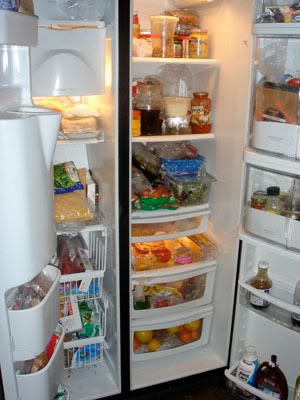
This is my Pantry:
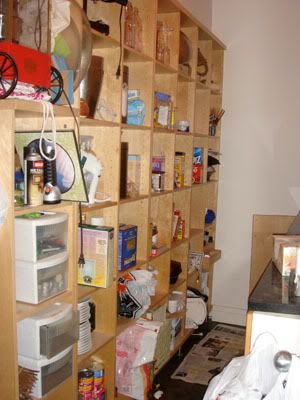
Chocolate Syrup
Joint Supplement
Capers
Teriyaki Sauce
Old Root beer
Jam (several kinds)
Ginger
Wasabi
Mustard
Peanut Sauce
2%
Whole Milk
Lots of Pulp Orange Juice
Lox
Cream cheese
Butter
Cheddar cheese
Grapefruit
Clementines
Lemon
Ginger root
Brown sugar
Carrots
Green onions
Olives
Rotisserie chicken
Organic Spring Mix - Mesclun
Green peppers
Mushrooms
Parsley
Apple Maple breakfast chick sausage
Prego Pasta Sauce
More Olives
Dog Food
Maple Syrup
Mayo
Smart Butter
Silk (soy milk)
Apple Sauce
Portabella Mushrooms
Garlic Pasty stuff
Hummus & More Hummus
Mango
Left over whole grain rice with vegetables
Turkey
Wheat germ
Chocolate sauce
Chocolate Frosting
Vanilla frosting
More Olives
Better than bouillon
Blueberries
Whole grain bread
Salsa
Munster
Brie
White cheddar
Jarlsburg
Tortilla
Tomatoes
Garlic
Organic eggs
Cat food
Beets
Celery
More green peppers
Potatoes
Artichokes
Cucumber
This is my Fridge:

This is my Pantry:

Subscribe to:
Posts (Atom)
